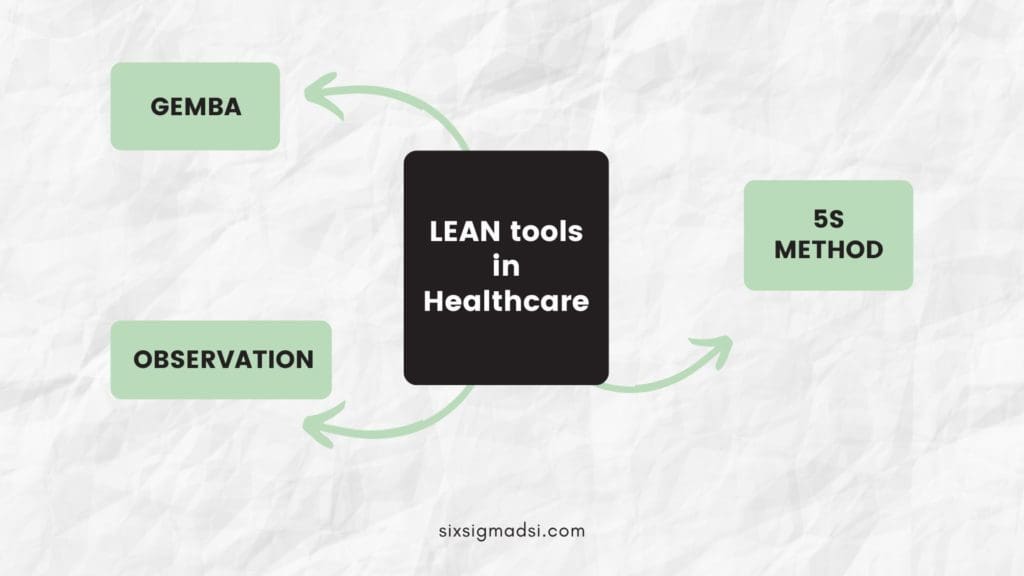Table of contents
- LEAN in Healthcare
- What Lean Healthcare isn’t
- What Lean Healthcare is
- Lean Healthcare Tools
- Implementing processes that are valuable from the patient’s perspective.
- Leaders and employees should align around a common vision
- Promotion of a culture that encourages continuous improvement
- To drive improvements, empower frontline staff
- Find the root cause for inefficiencies and pain points
- Flexibility and willingness for change
- Lean in action: Real results
- Related articles
LEAN in Healthcare
When Lean management methodology is applied in healthcare, it is often misunderstood. Some people mistakenly see Medical Lean process improvement management in healthcare as a way to cut costs. However, this is far from the truth. What does lean stand for in healthcare?
Healthcare Lean stands for creating value and reducing the burdens patients and staff face every day. Lean organizations do not focus on cutting costs, but instead on maintaining high standards of quality, safety, and satisfaction. This is achieved by aligning all employees around a consistent management structure and using that system to continuously promote, test, and implement process improvement.
While cost savings may not be the main objective of Medical Lean Management, they are often a result. Redesigning workflows and tasks to improve care often means saving time and other resources. This can also have other benefits, like empowering workers and increasing their engagement, and decreasing burnout.
Ultimately, terms such as Six Sigma and Lean are not more important than the strategies and concepts they represent. These strategies and concepts have been proven to work in many industries. They have the potential to make healthcare organizations more successful.
What Lean Healthcare isn’t
We are healthcare professionals who help our partners build their self-sufficiency. We often hear: “Isn’t Lean about cutting costs? Will that not harm patient care?
These questions can only be answered if you have the right motivation. Lean healthcare does not mean cutting costs. Lean healthcare is not about cutting costs. In most cases, however, the improvements you make to your bottom line by following Medical Lean principles can help. However, a patient-centered management system cannot be implemented to reduce costs.
What Lean Healthcare is
Medical Lean, as mentioned earlier, stands for putting patients first in healthcare. Medical Lean management systems encompass a variety of big-picture characteristics as well as day-to-day practices. These take time to implement.
A few core activities and principles can be used to define a Lean organization at a high level.
Lean Healthcare Tools

Implementing processes that are valuable from the patient’s perspective.
Success in healthcare is measured by the patient experience and outcomes. Every employee in a lean healthcare organization is expected to work according to the same standards.
It’s important to take the patient’s place. A team might look at the steps patients take each time they visit a provider. This allows the team to identify and eliminate roadblocks that patients might face, such as:
- Waiting for answers, providers, or services
- To find ancillary services, you will need to travel across the facility
- It is better to fill out paperwork in person than online.
While reducing wait times doesn’t always mean lower costs, there are other benefits. Patients who do their paperwork at home are more likely to be there on time. This helps ensure that all patients get the care they need. A patient who is more detailed and precise when entering current medication information may be able to make informed decisions about treatment and avoid dangerous drug interactions.
Leaders and employees should align around a common vision
Medical Lean methodology in healthcare management stands for encouraging everyone to do the most important work for the company. Leaders set clear goals while teams and individual team members create their own goals that are in line with those goals. If an organization wants to reduce central line infection by 80%, all the teams that handle central lines must agree to this goal. They will then iterate on solutions and track progress.
The alignment does more than just drive results for the organization’s priorities. This alignment also increases staff satisfaction and engagement by inviting them into the organization’s mission.
Promotion of a culture that encourages continuous improvement
Safety and quality cannot be achieved. They must be maintained. Lean process improvement in healthcare organizations provide the structure and culture needed to ensure that employees are able to maintain safety and quality in their everyday work.
This is contrary to quality “initiatives”, where quality improvement falls to a designated team or office for a specified time. How can one team impact quality across an entire organization? What happens after the initiative is taken?
These questions are not relevant to lean organizations. Every team works every day on improving quality.
To drive improvements, empower frontline staff
Only when frontline workers have the ability to lead, can constant improvement be achieved. Respecting the expertise of those who do the work is a central principle of Lean.
Leaders demonstrate respect by taking on the role as a problem- solver instead. This is healthcare leadership.
- You can physically go to the location where frontline staff provide care every day for patients
- Ask questions about the reasoning behind processes and see what your team members are doing.
- Encourage team members to make improvements
Leaders play the role of problem breaker and give their frontline colleagues the tools and time to identify inefficiencies and then design and implement better methods. The end result is that the whole team feels valued and engaged, which leads to improved patient care and satisfaction.

Find the root cause for inefficiencies and pain points
Root cause analysis is a key part of continuous improvement. This involves looking beyond the superficial to identify the root cause of the problem. Many root causes can be simple, like the location of equipment or how samples were labeled. These seemingly insignificant factors can cause unwanted or even dangerous outcomes and errors. These factors can be adjusted to make work safer and more efficient.
Respect for workers can also be shown by seeking out root causes. Leaders should not blame the person who made the mistake. Instead, they should partner with the person to discover why the error was made. What were the conditions that allowed this mistake to happen? What can we do to avoid future errors and promote safe, high-quality actions? Leaders can create an environment that encourages frontline staff to be more open and willing to share their ideas and focus on the process, rather than the individual.
Flexibility and willingness for change
The nature of patient care is dynamic. Like any other organization, lean ones will often attempt solutions that don’t work out as planned. This shows that being open to new solutions is more important than the initial desire to improve.
Medical Lean organizations are equipped with the mindset and tools to innovate, iterate, adapt, change, and improve their quality through strategic alignment, staff empowerment, and quality improvement.
Lean in action: Real results
Healthcare organizations can use a patient-centered approach to management. It can improve stewardship and deliver better care to patients faster and more cost-effectively.
Many organizations have realized the benefits of Lean methodology in healthcare.
- Continued improvements in patient safety –The University of Maryland St. Joseph Medical Center, (UM SJMC), partnered with Virginia Madison Institute to create and mobilize a single management platform that is accessible by all employees. Three years after its launch, UM SJMC was able to reduce its annual harm incidents by half. It also exceeded its goals for improving patient experience ratings and reducing injuries among employees. These improvements helped St. Joseph to earn many accolades. They received a five-star rating by the Centers for Medicare and Medicaid Services, a Leapfrog A grade for safety, and U.S. News and World Report recognition as the top Maryland community hospital.
- Lean process Improvement in patient flow in primary healthcare – The Virginia Mason Institute assisted WakeMed Health and Hospitals to improve ambulatory flow within its primary care clinics. Lean methods were used by teams to align around a common vision and form 5S deals, which are a way of improving safety and organization. They made improvements that allowed patients to be seen on time, accommodated walk-ins, and allowed staff to have a full lunch and return home on time.
- Improved patient outcomes – A Virginia Mason team was responsible for surgical instrument setup. They used root cause analysis and reduced errors to dramatically reduce prep time and minimize storage. The changes resulted in surgeons being able to perform more procedures and better meet patients’ needs.
what does Lean stand for in healthcare for you?
Let us know in the comments below.



















